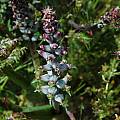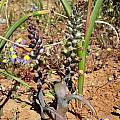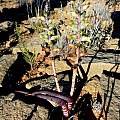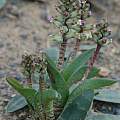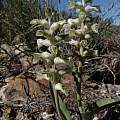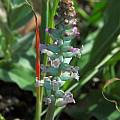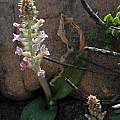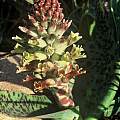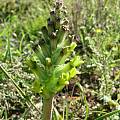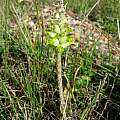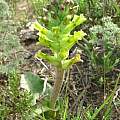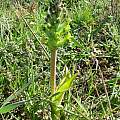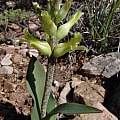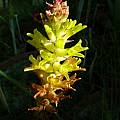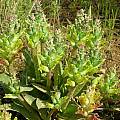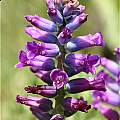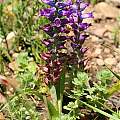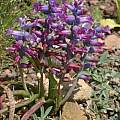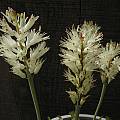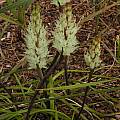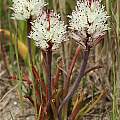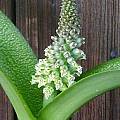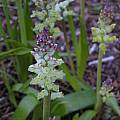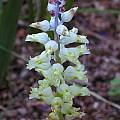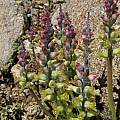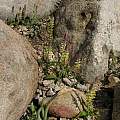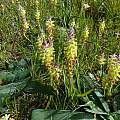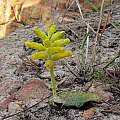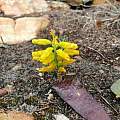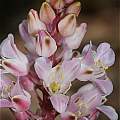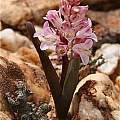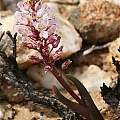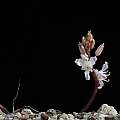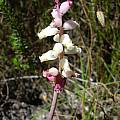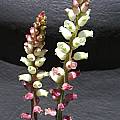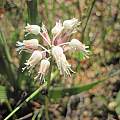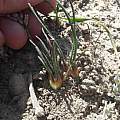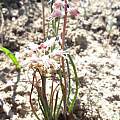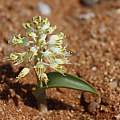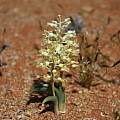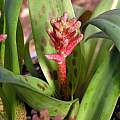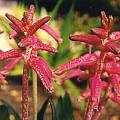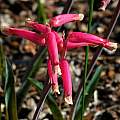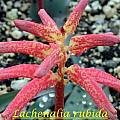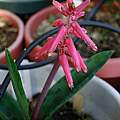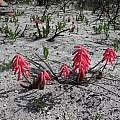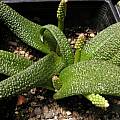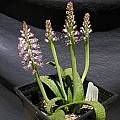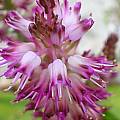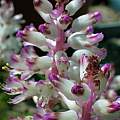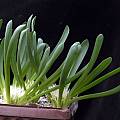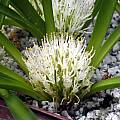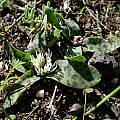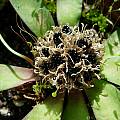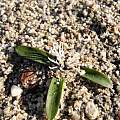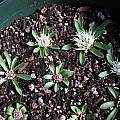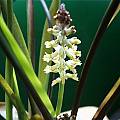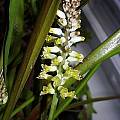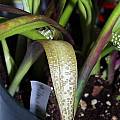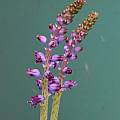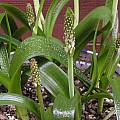Lachenalia is a genus with bulbs in the Hyacinthaceae family found in Namibia and South Africa. There are around 133 species. A complete illustrated systematic monograph of this genus by Graham Duncan, The Genus Lachenalia, was published in 2012. Lachenalia species o-p are found on this page.
Lachenalia a - Lachenalia b-c - Lachenalia Species d-i - Lachenalia j-n - Lachenalia q-t -Lachenalia u-z - Polyxena - Lachenalia index
Lachenalia obscura Schltr. ex G.D.Duncan grows on stony karroid flats from Namaqualand to the Karoo. Growing from 6 to 38 cm high, it has 1 to 2 leaves and bell-shaped flowers that are sessile to subsessile and cream to brownish blue, sometimes with magenta tips. Anthers are included. Flowering occurs between June and October. The first photo was taken by Mary Sue Ittner September 2006 near Middelpos in the Roggeveld and the next two by Cameron McMaster in the same area at another time. The fourth photo is from Rod Saunders. The last photo from the book Plants of the Klein Karoo courtesy of Jan and Anne Lise Schutte-Vlok.
Lachenalia orchioides (L.) Aiton is a variable usually montane species often found growing in heavy soil in partial shade in large colonies. Growing from 10 to 40 cm high, it has 1 to 2 lanceolate or strap-shaped leaves and sessile flowers with anthers included. It flowers August to October. There are three accepted subspecies.
Lachenalia orchioides ssp. glaucina (Jacq.) G.D.Duncan, syn. Lachenalia glaucina Jacq., has sessile turquoise sweetly smelling cylindrical flowers with the anthers included. The outer tepals are light blue to purplish blue with dark blue to purple blue gibbosites and the inner tepals white to shades of blue. Don Journet wrote: "The purple flowers make this variety a striking specimen and well worthy of inclusion in a collection. For me this variety flowers between the third week in September and the first week in November putting it towards the end of the flowering season." The first two photos were taken September 2006 at Lion's Head by Mary Sue Ittner.
Lachenalia orchioides ssp. orchioides is the most widespread variety. It has sessile greenish yellow sweetly smelling cylindrical flowers with the anthers included. The flowers fade to dull red as they mature. The first photo was taken by Rachel Saunders, the next four by Cameron McMaster taken near Napier in the Overberg and the last photo from the book Plants of the Klein Karoo courtesy of Jan and Anne Lise Schutte-Vlok.
Photos from Alan Horstmann.
Lachenalia orchioides ssp. parviflora (W.F.Barker) G.D.Duncan, a new subspecies from 2012 has shorter outer tepals and violet flowers. The photos below from Andrew Harvie identified as ssp. glacina before ssp. parviflora was described may be parviflora. They were photographed at Devil's Peak in Table Mountain National Park where that subspecies occurs. The last photo from Rod Saunders may also be this subspecies.
Lachenalia orthopetala Jacq. has grass-like leaves that are fleshy with a deep central channel and upward facing white bell-shaped flowers with very distinctive dark brown gibbosities adding contrast. The peduncle is also a contrasting deep maroon which helps set off the white flowers. This late blooming species is very similar to Lachenalia contaminata. Some of the description is from Don Journet. It grows in clay soils in the Northwest and Southwest Cape and blooms in spring. The first two photos by Mary Sue Ittner of plants grown from seed and blooming in Northern California in April. The last photo was taken in habitat in the Western Cape by Andrew Harvie.
Lachenalia pallida Aiton is found on clay flats in large colonies in the Northwest and Southwest Cape. In Graham Duncan's 2012 book he proposed including Lachenalia gillettii W.F.Barker, Lachenalia pustulata Jacq., and Lachenalia unicolor Jacq. in this species. It is found on clay flats in large colonies in the Northwest and Southwest Cape. The oblong-campanulate flowers are cream to dark yellow with brown or green markings, fading to dull red. Flowering occurs between August and October. Photo 1 was taken by Doug Westfall and 2-3 by Mary Sue Ittner. It is a good species for naturalizing. Photo 4-5 were taken by Nhu Nguyen at the UC Botanical Garden.
The first photo was taken by Cameron McMaster near Darling in the southwest Cape September 2011. The second photo from Alan Horstmann.
Lachenalia patentissima G.D.Duncan is a dwarf plant growing from 8-13 cm tall with a solitary plain or spotted leaf, an erect green scape marked with purple blotches, a light green rachis, and a widely spreading perianth with bright yellow to greenish yellow flowers. It is restricted to the Cape of Good Hope Nature Reserve where it grows in sandstone fynbos vegetation and flowers September to October. Photos from iNaturalist taken by Jean_S and Justin Hawthorne in the end of August and in September and shared under a CC BY-NC license.
Lachenalia patula Jacq. is a dwarf species found on quartz hillsides in the northwest Cape. It has white to pale pink campanulate flowers on long pedicels. The first three photographs were taken in Namaqualand by Andrew Harvie. The last photo from Bert Zaalberg.
Lachenalia peersii Marloth ex W.F.Barker is a late blooming species with a fragrance that is reminiscent of carnations. It flowers in profusion after fires and is common in Betty's Bay, Hermanus and Caledon. It has one or two lorate unmarked leaves and white flowers with green or greenish brown gibbosities. The first photo was taken by Cameron McMaster near Hermanus and the next by Mary Sue Ittner of cultivated plants.
Lachenalia polyphylla Baker is a very rare dwarf species known from less than 10 severely fragmented subpopulations between Piketberg and Gouda where it grows in moist, open, clay gravel flats. It has five to eight grass-like leaves with swollen leaf bases that are maroon colored in the upper half and covered with tiny hairs. Flowers are light whitish blue with dull rose-pink to reddish brown gibbosities. Stamens are well exserted and recurved. Flowering is from September to October. Photos below from iNaturalist were taken in the West Coast area of the Western Cape by Riaan van der Walt and Stephen Cousins and shared under a CC BY-NC license.
Lachenalia polypodantha Schltr. ex W.F.Barker is native to the Northern Cape where it grows on flats in deep red granitic sand or gravel. It is a dwarf species from 4 to 15 cm high with a solitary lanceolate leaf and campanulate white to violet flowers with exserted stamens. This species flowers August to September. There are two subspecies. Subspecies polypodantha has a dark green spreading leaf with a flat upper surface and light violet inner tepals and violet filaments.
Lachenalia polypodantha ssp. eburnea G.D.Duncan has a glaucous curved leaf with a grooved upper surface and ivory white inner tepals with green or brown keels and white filaments. It has a more limited distribution near Gamoep in western Bushmanland. Photos from Alan Horstmann taken in October.
Lachenalia punctata Jacq. was recognized as the correct name for this species in 2012 when Graham Duncan published his book. It had been known as Lachenalia rubida Jacq., but the name Lachenalia punctata had been published earlier. Growing from 6 to 25 cm high, this species has one or two green or spotted leaves and shortly pedicellate nodding plain or spotted red or pink flowers. Anthers are included. It grows on sandy flats and slopes over a broad area from the Western to the Eastern Cape flowering from March to July. The species is well worth including in any collection and is relatively easy to cultivate. The first three photos from Mary Sue Ittner show California plants grown from seed. The fourth photo is provided by Bill Dijk. The fifth photo is of the plain form, by Michael Mace. The last photo from Rachel Saunders was taken near Kommetjie (southwest Cape) where it was in bloom after fire, April 2011.
Lachenalia purpureocaerulea Jacq. is a late bloomer (spring) and has two pustulate leaves and bell-shaped white to blue flowers at the base shading to magenta or purple. It is fragrant and the exserted anthers add to the beauty of the plant. It is from the southwest Cape where it grows in gravel flats. Photos by Bob Rutemoeller and Alan Horstmann.
Lachenalia pusilla Jacq. is a short plant with white flowers that are borne at ground level in a congested raceme. The four to six leaves are produced in a prostrate rosette and may vary in shape from linear to lanceolate and are plain or spotted. The peduncle or main flower stem is very short resulting in flowers opening at ground level. This appearance is probably why the species was at one stage included in the genus Polyxena. Because of its geometry this species is probably best suited to cultivation in pots or raised containers. As the seed matures the peduncle extends raising the seed capsules above the plant to presumably aid in seed dispersal. Information from Don Journet. The flowers have a scent that resembles coconut. It blooms in the fall and is common on sandy flats and slopes in the winter rainfall areas. the first two photos were taken by Mark Mazer and the next two by Cameron McMaster taken near Napier in the Overberg. His second photo shows the plant in seed. The fifth photo is from Rod Saunders. The last photo from Mary Sue Ittner gives an idea of how small these plants are as there are a number of plants in bud and bloom in a pot.
Lachenalia pustulata Jacq. was proposed to be included in Lachenalia pallida Aiton in Graham Duncan's 2012 book. It is a species of the southwest Cape that is often found growing in large colonies in heavy soil. It grows from 15 to 35 cm and has narrowly bell-shaped flowers on long pedicels in shades of cream, blue, or pink with green or brownish markings. Duncan states it is scented although Arnold Trachtenberg who furnished photos 1-3 detects no scent. Photos 4-5 from Mary Sue Ittner. It is very similar to Lachenalia unicolor Jacq.
Lachenalia a - Lachenalia b-c - Lachenalia Species d-i - Lachenalia j-n - Lachenalia q-t -Lachenalia u-z - Polyxena - Lachenalia index
